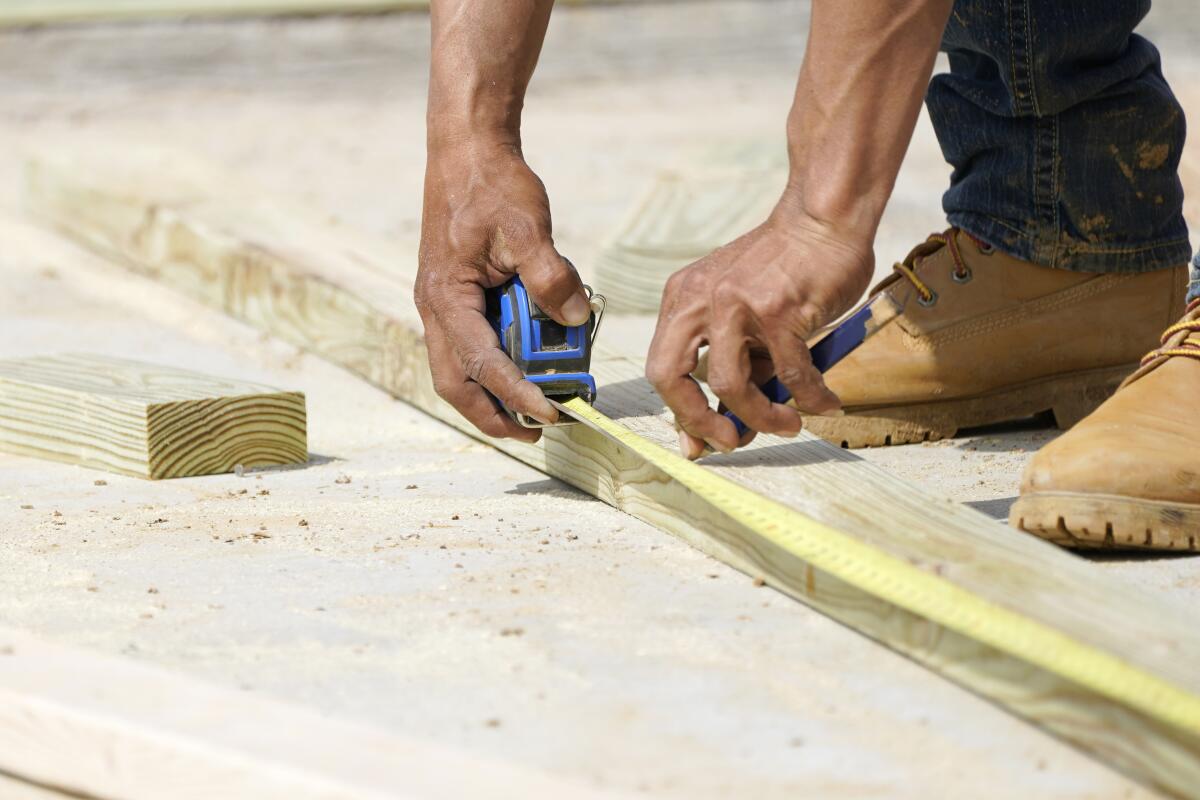Five tips to tackle a home remodel in an uncertain economy

- Share via
Spring is kickoff season for many kitchen remodels, bathroom updates and deck repairs, but recent economic turmoil may have homeowners questioning their home improvement plans.
Spending on home renovations is expected to slow this year because of factors such as declining home sales and values, rising interest rates , continuing inflation and rumblings of a coming recession, says Abbe Will, senior research associate with Harvard University’s Joint Center for Housing Studies.
As economic growth slows, planning and prioritizing will be key to remodeling confidently. Here are tips to help you remodel in an uncertain economy.
Start with an emergency fund
Even when the economy is doing well, it’s ideal to have an emergency fund before starting a remodel, said Eric Maldonado, a certified financial planner based in San Luis Obispo.
Your first priority should be building an emergency fund. Most financial planners recommend having a reserve of 3 to 6 months’ worth of expenses.
“What you’re trying to avoid is starting with nothing saved, taking out debt to afford these things and not really providing yourself with a smart foundation to start from,” he says.
A six-month fund is a good goal, he says, especially if you’re concerned about losing your job.
Narrow your financial goals
After your emergency fund is set, put remodeling on a short list of your financial priorities for the year and distribute your budget accordingly, Maldonado said.
For example, if your main goals are to pay off debt, contribute to your kids’ college funds and begin home improvement projects, determine how much each goal costs and how much you can afford to spend on them every month, he said.
“It’s kind of like putting the big rocks into the jar first,” he says.
This may mean slowing progress toward other financial goals, such as early retirement or purchasing a new car.
The 50/30/20 budget was popularized by Sen. Elizabeth Warren and her daughter Amelia Warren Tyagi in their book, “All Your Worth: The Ultimate Lifetime Money Plan.”
Prioritize repairs and small updates
If high gas and grocery bills have left you with less to spend on home improvements, prioritize projects that have the potential to affect your finances the most, said Katherine Fox, a certified financial planner based in Portland, Ore.
Fox recommends starting with fixes that would be costlier to delay, such as a leaking pipe. Then, consider updates that will save you money in the future, such as new windows or insulation that may lower your utility bill.
Look for opportunities to mix “nice-to-haves” with “must-haves,” she said.
“Maybe you have something behind a wall that needs to be fixed, so you have to open up a wall, and then you have to repaint,” she says. “Maybe you take this opportunity to fix a need and get a want at the same time.”
Fully permitted accessory dwelling units are so new, appraisers say, there’s too little information to say with much certainty how much value they add to a home.
Compare financing options
The Federal Reserve’s persistent interest rate hikes over the last year have led to higher rates on most financing options, so you’ll probably pay more interest on a new home improvement loan than you would have before.
Maldonado said home equity loans and lines of credit are typically the lowest-rate options, but he recommends comparing financing options to find the best rate and terms.
Most home equity and personal loans come in a lump sum and have fixed interest rates, so your monthly payment remains the same for the full term.
A home equity line of credit, or HELOC, provides more flexibility for large projects because you can draw on it as needed for up to about 10 years. However, HELOCs typically have variable rates, which means monthly payments can fluctuate.
The norms around whom, and how much, Americans tip have shifted in recent years — and consumers are increasingly confused.
Consider delaying to save money
While prioritizing projects, decide whether you can delay any for a year or more. As fickle as the economy has been, there are signs that those who wait could pay less.
The pandemic-induced remodeling frenzy triggered a sharp increase in labor and materials costs that homeowners felt last year, according to a March 2023 report from Harvard’s Joint Center for Housing Studies. Cement, brick and plywood prices rose 20% to 25% between March 2020 and December 2022, the report found. Insulation material costs rose 34%. This year, materials may get cheaper, the report said.
Likewise, home improvement spending is expected to decline in early 2024 for the first time in more than a decade, according to the center’s Leading Indicator of Remodeling Activity, which measures and projects remodeling spending.
If you can tolerate the guest bathroom as it is or stomach that non-load-bearing wall for another year or two, you could get the work done at a discount, Fox said.
Just be sure you’re in a secure financial position and feel good about your employment prospects if you bet on a recession, she said.
Millerbernd writes for personal finance website NerdWallet. This article was distributed by the Associated Press.
More to Read
Inside the business of entertainment
The Wide Shot brings you news, analysis and insights on everything from streaming wars to production — and what it all means for the future.
You may occasionally receive promotional content from the Los Angeles Times.














